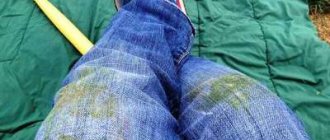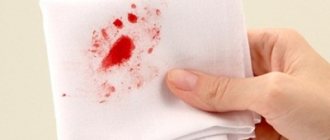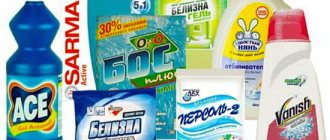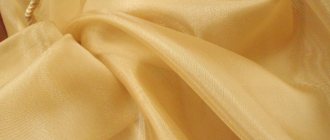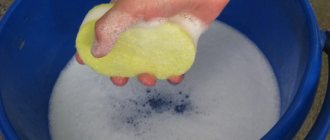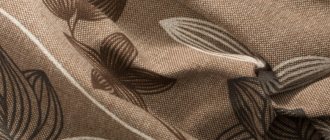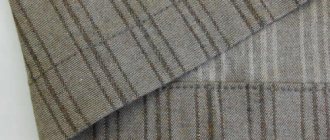Even when buying sling scarves from well-known companies, buyers are often faced with the stiffness of the fabrics, and this is upsetting. I would like to offer several options to make it pleasant to carry your child on yourself))
1) To soften 100% linen fabric, the method of soaking in salt, or more precisely in salt water, is used. Overnight we leave the fabric in a container with “salted” water (I like sea water with foam most of all, but you can also use table salt, about a glass for a small basin), in the morning wash in the machine at 60 degrees and squeeze out the maximum number of revolutions, you can also add rinse aid, which will also soften the fabric, but I would use it only if you are absolutely sure that no allergies will follow. After washing, straighten the fabric as if “shaking” it. Iron with steam while it is wet. The softened sling (or fabric) is ready.
Linen is afraid of little, and such manipulations give it softness without damaging it, but this is exactly linen, what to do, for example, with cotton, or even with flax, but if you are really afraid for your already beloved purchase?
2) For a sling, you can use braiding)) It is woven like the set of the first row and when crocheting, only instead of a hook there is a hand. We make a loop, stick our hand in there and pull out the next loop, and so on until the tail. Braiding helps)), but these manipulations should be repeated several times.
3) You can use the dry pressing method. Load the fabric into the machine and set it to spin at maximum speed, without rinsing, or with rinsing, as your time allows, then it’s better to iron wet or dry, but always with steam.
Tested by me, on the slings that I sew, everyone who buys asks how I achieved softness, so I decided to share the information that I myself once dug up in the vastness of the RuNet.
I hope my experience will help those who are faced with a similar problem.
www.livemaster.ru
Linen fabric is made from plant-derived flax fiber and is highly prized for its durability, gloss, and ability to breathe on hot summer days. However, it wrinkles too easily and can be stiff and rough. You can easily soften such fabric, make it smooth and silky on your own. Get your linen bedding ready for summer ahead of time!
1. Soak linen fabric in hot water. Change the water as needed. Linen has excellent resistance to heat, and the warm temperature allows the fibers to “relax” and, as a result, increase the softness of the fabric.
2. Use more “shaking and kneading.” The more often linen is washed and spun during the spin cycle, the softer it becomes because the fibers are gradually broken down during the process. Don't worry, not so fast that 4-5 washes or more will in any way damage your favorite napkins or bed linens. Wash linen more often.
Another way is to take a dry linen cloth and spin it in the machine only on the spin mode at maximum. Repeat if necessary.
An analogue is to braid the fabric, that is, wrinkle and rub it. Make a loop at the end of the fabric, pull the long end through it, forming a second loop, through a new one - and so on until the end. You will have to repeat several times, starting from different sides.
3. Make sure that the chemicals you use for washing do not contain starch or other agents (such as zeolites) that make the fabric stiff. It is well known that starch has long been used to literally make fabric stand up. By the way, hard water gives a similar effect.
4. Add an acid-forming agent when washing. White vinegar is a good option. The presence of acid will make the fabric soft: the acid combats the stiffening effect of micro-particles of detergent stuck in the fabric.
Or use a homemade soaking solution. The following recipe works great for flax: mix 1 tablespoon of white vinegar and 4 cups of warm water in a bowl. Soak the flax in this for 20 minutes. Do this every time before washing.
5. Invest in a really good air conditioner. German, for example. Believe me, the comfort on summer nights is definitely worth it!
6. Leave the flax overnight soaked in salt water. This method is only suitable if the fabric is completely natural, that is, it consists exclusively of linen.
7. Dry linen exclusively naturally after washing, and if it is a little damp. Iron only dry material.
Add-ons:
A. When flax is subjected to sudden changes in temperature, it tends to shrink. And, accordingly, become tougher. Therefore, do not use a centrifuge dryer; hang the linen product on ropes. Likewise, do not take linen out of the washing machine straight into a cold room with open windows.
B. If possible, set your washing machine to double or triple rinse when washing so that even a minimum of detergent is not left in the fabric.
Q. Practicing the right methods will move mountains. Experiment with all the methods and then stick with what works best for you on an ongoing basis.
www.znaikak.ru
Tips for softening linen fabric
Here are several options for softening linen fabric:
- Method one. It is characterized by a rather aggressive approach and is suitable exclusively for fabric made from linen without any additives. The main ingredients used in this method are water and salt. You will need a glass of salt for a medium-sized basin. You can take a regular one, a kitchen one, but the one designed for bathing will also work. Place the tissue in a saline solution and keep it there overnight. We wash the rum in a machine at a temperature of no more than 60 degrees. There is no need to use more water than specified, as this will result in crumpled, chewed-up products. In addition, they can shrink, which is completely undesirable for clothing. You can also add a dose of conditioner to enhance the softening effect. After washing, shake off the fabric, straighten it and iron it until it is completely dry. It is important to note that linen fabric, which has been washed several times, itself becomes softer. Therefore, housewives recommend to soften the products, even if this is not required for reasons of cleanliness, to wash linen items several times so that they become softer.
- Method two. It uses a two percent acetic acid solution. It is recommended to leave things in the solution for several hours, and then rinse well. You should not be afraid that the products will smell of acid; it will disappear when dried.
- Method three. Soaking the fabric in hot water. The effect of “relaxation” of the fibers is used here. Linen is a durable fabric and is not afraid of heat. Relaxation of the fibers increases the softness of the fabric and makes it more pleasant to the touch.
- Method four. Spin the dry linen fabric several times in the machine on spin mode at maximum.
- Method five. Braid the fabric by making a loop at the end of the fabric and pulling the long end through it, forming a new loop, then another. It is recommended to repeat the procedure several times.
It is also advised to make sure that washing powders do not contain substances that can make the fabric more rigid - starch, for example, or zeolites.
An acidifier added during washing will help make the fabric softer. For this purpose, it is good to use white vinegar.
With these softening methods, not a single thing will lose its shape, even linen dresses and linen sundresses will retain their style and look like new.
ovechka-marta.ru
HOW TO MAKE LINEN FABRIC SOFTER. 8 RULES We can talk endlessly about the positive qualities of linen fabric. This material, beloved by many, is a real champion in strength and benefits for the body. But sometimes, when purchasing natural linen, housewives are faced with its initial stiffness and roughness. These 8 tips will help you easily solve this problem and make your linen fabric soft and flowing. 1. Almost enzyme wash. This is a technological term used by linen manufacturers to soften the fabric. Enzyme wash - washing with the addition of enzymes, the particles of which have a friction effect.
This means that we need to wash in such a way that something has an additional effect on the fabric. You can load special fabric softening balls into the washing machine drum; they are available for sale online. Or you can (if you are not allergic to latex and rubber) load tennis balls or children's bouncy balls. Or anything else that will create additional stress on the fabric. When washing rubber, silicone latex products, you need to do it at low temperature. 2. Salt. The following solution helps soften linen fabrics very well: 4 tbsp. salts should be diluted in a bowl of water and the laundry should be left in it overnight, and then rinsed and washed in the morning. 3. Soda. Before you start washing, you should dissolve half a glass of soda in the water in which you are going to wash your clothes. Baking soda softens water and thereby softens laundry and clothing. 4. Massagers as ethnic rollers Previously, linen cuts were rolled onto a relief roller and rolled with a relief spatula. Now we can take wooden massagers and try to recreate the process. The flax fiber that has swollen over night in salt water can be “fluffed” by giving it a long and high-quality massage. 5. Acid. Citric acid or vinegar added to the rinse water will help soften the laundry. Vinegar is not as effective at softening as baking soda. However, vinegar has one useful property: it removes detergent residues and unpleasant odors. 6. Let's shake ourselves up! Flax likes to be shaken wet. Wash, wring out and shake, straightening the fabric. Then the fibers fall into place and are saturated with air. 7. Steam Steaming helps a lot. The still wet flax is removed undried and steamed. Ideally hanging so as not to “seal” the fabric. But you can also use a plump terry towel if you have nowhere to hang a large cloth. 8. Dry wash The more you pull, wrinkle, squeeze, shake and rub the linen, the softer it will become. For long cuts, a good remedy is “braiding” and twisting strands. Buy high-quality linen fabric here - https://goo.gl/qVe4UL
ok.ru
I love linen very much, it has a lot of advantages, but I have to think about one drawback. New linens - in a product or a cut (and for me - in slings)) - always stand upright, they are cardboard and wooden. You'll suffer with such sacks! But softened linen clings and flows, and there is no fabric more tender than it. Here are my 10 ways to tame the shrew. add yours.
1. Len loves hands
, so hand washing and hand spinning is the best way to negotiate with it. There is an opinion that new linen should be machine washed at high speed. Of course it is possible. But if it’s a machine, then the wool or hand wash mode. Plus - liquid detergent. Better yet, use your hands: knead, squeeze, rub, wring out, rinse, twist - all with your hands. And hallelujah! - with good old laundry soap 72% fat content))) below - about floggers additional devices for extracting softness
2. Let's shake things up!
Len loves to be shaken wet so that the splashes fly. Wash, wring out and shake, straightening the fabric. Then the fibers fall into place and are saturated with air.
3. Almost enzyme wash
.
This is a technological term used by linen manufacturers when softening the fabric, especially for export. Enzyme wash – washing with the addition of enzymes. Enzyme particles have a friction effect. That is, we need to wash in such a way that something has an additional effect on the fabric. This is a technological term used by linen manufacturers when softening the fabric, especially for export.
Enzyme wash – washing with the addition of enzymes. Enzyme particles have a friction effect. That is, we need to wash in such a way that something has an additional effect on the fabric. » /> You can load special balls into the washing machine drum to soften the fabric, but these are not available for sale online. Or you can (if you are not allergic to latex and rubber) load tennis balls or children's bouncy balls. or anything else that will create additional stress on the fabric. When washing rubber, silicone latex products, you need to do it at low temperature. 4. Salt.
The following solution helps soften linen fabrics very well: 4 tbsp. salts should be dissolved in a basin of water and the laundry should be left in it overnight, and then rinsed and washed in the morning.
5. Soda.
Before you start washing, you should dissolve half a glass of soda in the water in which you are going to wash your clothes. Baking soda softens water and thereby softens laundry and clothing.
6. Massagers as ethnic rollers
The following solution helps soften linen underwear very well: 4 tbsp.
salts should be dissolved in a basin of water and the laundry should be left in it overnight, and then rinsed and washed in the morning. 5. Soda.
Before you start washing, you should dissolve half a glass of soda in the water in which you are going to wash your clothes. Baking soda softens water and thereby softens laundry and clothing.
6. Massagers as ethnic rollers
Previously, linen cuts were rolled onto a relief roller and rolled with a relief spatula.
Now we can take wooden massagers and try to recreate the process)) the flax fiber that has swollen overnight in salt water can be “fluffed” by giving it a long and high-quality massage. back and forth. along and across. unfolded, shook, folded and again, again, again. a very meditative activity. helps with postpartum depression)) 7. Acid.
Citric acid or vinegar added to the rinse water will help soften the laundry. Vinegar is not as effective at softening as baking soda. However, vinegar has one useful property: it removes detergent residues and unpleasant odors.
8. Steam
Steaming helps a lot. While still wet, the flax is removed half-dried and steamed. Ideally, it should be suspended so as not to “seal” the fabric and flatten the fibers. But you can also use a plump terry towel if you have nowhere to hang a large cloth.
9. Dry wash
The more you pull, wrinkle, squeeze, shake and rub the linen, the softer it will become. For long cuts, a good remedy is “braiding” and twisting strands.
10. dry massage
nice for both flax and man! - my favorite way) wrap flax on a massage rolling pin or roller and stand on it with your feet, massage each other, roll, roll, trample. it's a thrill!
***************************************** on ten rules “what to do” I have only two tips on “what not to do.”
1. Do not wash linen with washing powder! Powder microparticles enter the swollen fiber, which then contracts when dried. And powder particles tear it from the inside, disrupting the structure.
2. You can, of course, use a mouthwash... BUT! Why do you need extra chemicals on your skin? Lately I haven't softened my linen with fabric softener.
yu-de-ki.livejournal.com
Types of linen fabrics and their properties
Fabrics made from linen raw materials are in increasing demand due to their combination of advantages.
- Linen is a material native to the Slavs. It evokes pleasant associations, looks great, does not irritate the skin, and does not cause allergic reactions.
- Linen fabric has micropores through which air circulates well. The fabric “breathes” better than most other textile materials.
- Linen fabrics provide thermal comfort. During the hot season, a person wearing linen clothes does not overheat.
- Linen is a very durable material that is difficult to wear out.
- The high creaseability of fabric is now perceived positively by consumers, as it demonstrates the naturalness of the fabric and its high cost.
- Some rigidity of the material can also be assessed as a positive characteristic, allowing designers to model products with a pronounced shape.
Flax, native to the Slavs, looks beautiful.
The media contains information about the bactericidal qualities of linen materials. This raises reasonable doubts. The probability of maintaining a sufficient concentration and activity of substances with antimicrobial action during the entire production cycle of transforming the plant into the final product is too low. There are many stages, the conditions are tough.
A close study of the issue revealed the following:
- Botanical reference books contain information about the content of mucus-forming substances in flax, which can swell in hot water and envelop the wound. We are talking about the presence of such substances in plants of a certain type, and not in tissues.
- Linen fabrics have a high sorption (absorbing) capacity.
- Absorbing secretions on damaged skin certainly has a positive effect. Microbes do not remain in the wound, but are absorbed by the tissue, which can be replaced.
- Domestic enterprises have introduced a method for producing flax wool with high absorption capacity. The technology for the production of dressings from flax has been successfully tested and is being prepared for mass implementation.
- Methods for applying coatings with bactericidal properties to flax fibers and threads are being developed.
From this, an incorrect conclusion was drawn about the bactericidal properties of linen fabrics.
This material has many true advantages, proven by many years of use.
Cotton
The high rigidity of cotton fabric is due to the processing of threads using special glue. To soften the material, you need to wash the item of clothing several times with regular powder, and use conditioner when rinsing. After 2-3 such procedures, the textiles become softer.
Note : Cotton clothing should not be washed at temperatures above +60 degrees, as this may cause the product to shrink.
nice for both flax and man! - my favorite way) wrap flax on a massage rolling pin or roller and stand on it with your feet, massage each other, roll, roll, trample. it's a thrill!
***************************************** on ten rules “what to do” I have only two tips on “what not to do.”
1. Do not wash linen with washing powder! Powder microparticles enter the swollen fiber, which then contracts when dried. And powder particles tear it from the inside, disrupting the structure.
2. You can, of course, use a mouthwash... BUT! Why do you need extra chemicals on your skin? Lately I haven't softened my linen with fabric softener.
yu-de-ki.livejournal.com
Classification by weave type
- Of all types of simple weaves, plain weaves are used for linen threads.
- The range of linen fabrics includes products with finely patterned weaves (modification of matting).
- Beautiful products are obtained from canvases made using a combined translucent weave. These can be whole products or individual fragments.
- Fabrics for sewing light dresses, blouses, and curtains can be made using the technique of complex leno weave, which is called openwork.
- Fabrics for tablecloths, napkins, curtains, dresses, and suits are often obtained by performing large-pattern weaving on special jacquard machines.
The above types of weaving are performed in the production of homogeneous linen or mixed fabrics.
Linen
To soften linen fabrics, it is necessary to soak the items in 5-7 liters of water diluted with 3-5 tablespoons of table salt. Leave the clothes in a container of water overnight and wash them in the morning.
Alternative ways:
- Dilute two doses of conditioner in a basin of warm water and immerse things there for a day. After 24 hours, clothes should be rinsed or washed with conditioner.
- Pour acetic acid into a basin of water to a two percent solution and soak the clothes in the reservoir for several hours. Next, rinse the item well several times. If after a set of procedures a sour smell remains, you can wash it.
More information about clothing care can be found from the manufacturer Vulkana.
www.vulkana.ru
How to use seeds for weight loss
Colon cleansing invariably leads to slight weight loss and improved gastrointestinal function, but more can be achieved. With proper use of mucous jelly, appetite is reduced, overeating is prevented, metabolism is improved, and beneficial microelements and fatty acids will guard women's health and beauty.
How to brew and take flax seeds for weight loss
Action: Reduce appetite, improve metabolic processes, normalize stool, prevent constipation.
Ingredients: Seeds – 3 tsp. Water – 600 ml
Application: Sort out the flax, pour into a thermos, pour boiling water from the kettle, stir. Close and leave overnight. Open in the morning, stir, drink 30 minutes before breakfast. Repeat before lunch and dinner. It is important to stir so that the seeds in the drink are distributed evenly.
Rich decoction for weight loss
Action: Has a mild laxative effect, reduces hunger.
Ingredients: Flax seeds – 1 tbsp. l. Water – 500 ml
Application: Combine flax seeds with water, bring to a boil, reduce heat to low, cover the pan, simmer for 1.5 hours. Strain, take 0.3 cups 30 minutes before meals at least 4 times a day.
Video: Recipes for cooking flax for weight loss
What to do if stains appear on linen clothes?
The problem can be solved both in dry cleaning and at home.
- Treat sweat stains with a mixture of wine alcohol and citric acid. For one hundred grams of wine alcohol we take ten grams of citric acid. Soak the stain in the solution for several minutes and rinse very thoroughly with warm water.
- Another folk remedy for removing sweat stains: dissolve a teaspoon of salt in two hundred grams of water and add the same amount of ammonia. We treat stains and rinse the product several times.
- Ammonia is indispensable for removing grease stains. Add one teaspoon of ammonia to a glass of water and wipe the stain. Rinse with warm water. You can also get rid of fresh blood stains using the same method. Please remember that blood stains should not be washed off with hot water.
- Wash stains from berries, fruits, and wine immediately with warm water. If this is not possible, when you come home, wash the stain in hot milk. Stains on light-colored fabric can be treated with hydrogen peroxide.
- Do not use bleach or chlorine-containing substances to remove stains on linen; they make the flax fibers thin and the fabric turns yellow.
Linen - what kind of fabric is it?
Flax began to be cultivated as a crop back in the Neolithic era (8th–3rd centuries BC). This is confirmed by the finds of samples of linen fabrics that were discovered during excavations of an ancient village in Switzerland. They have been preserved in museums to this day. Other later examples of linen fabric were found by archaeologists on the remains of Egyptian pharaohs.
The production of flax fiber in ancient times can be judged from wall paintings in Egypt, frescoes and drawings on Greek vases. They show how flax was processed in those days: it was pulled, spread, dried, crushed, ruffled, carded and spun by hand using a spindle hanging on a thread.
How flax was produced in villages in Europe (step by step).
How flax is produced in Europe these days (English voiceover)
Later, flax was widely used in Rus', Assyria, India, Persia, Mesopotamia and Rome. In our homeland, flax was treated with special respect and awe: it was valued for its healing and cleansing properties. Clean and white linen clothing was a symbol of innocence and moral purity.
Production of linen fabrics
The production of linen fabric is not difficult, but it is quite labor-intensive. Its main stages:
- Harvesting flax and obtaining flax straw (by combines or other machines).
- Soaking flax straw. To do this, spread the stems in the fields for 2-3 weeks to soak them in dew.
- Primary processing: drying, crumpling, scuffing.
- Spinning production: obtaining yarn (carding, forming a sliver, obtaining a roving from a sliver - a thin twisted sliver).
- Weaving: making fabric (on a loom with two thread systems).
- Finishing production: bleaching, painting.
Combed flax produces a thinner linen yarn that is better in many characteristics and quality. It is used for the manufacture of linen, towels, sheets, table linen, light suiting fabrics, tarpaulins, fire hoses. Tow (short fiber) and bast produce a coarser yarn. Coarse fabrics are made from it: canvas, bag fabrics, linens.
Waste from flax production is used as fuel. They are also used to make slabs for wall partitions and are used in the production of furniture and parquet flooring. As you can see, not a single part of the flax is recycled, everything finds its use.
Properties of flax
Main properties of linen fabric:
- Absolutely environmentally friendly.
- High thermal conductivity.
- Wear resistance and strength.
- Breathability.
- Minimum electrification.
Linen types of fabrics are one of the few that are made from completely natural raw materials. Linen has valuable hygienic properties, for example, the ability to remove heat and moisture. In hot weather, a person dressed in linen clothing has a body temperature 3-4 degrees lower than in clothing made from other fabrics (especially synthetics).
It has also been proven that wearing linen clothes prevents some diseases, since linen has rare bacteriological properties - neither fungus nor bacteria get along on it. This completely clean eco-friendly fabric is considered a natural antiseptic. Flax also kills germs and various infections; wounds under flax bandages heal faster. Flax contains silica, which inhibits the development of bacteria.
Currently, flax is the only and invaluable plant material used for suturing in surgery: our body does not reject it and completely resolves it.
Features of care
White and natural (not dyed) linen fabrics can be washed at 90 degrees, and after washing they can also be boiled. Colored items should be washed at a temperature not exceeding 40 degrees. But if vat dyes were used for dyeing, then washing at high temperatures will not damage the color. Regardless of the type of dye, wash linen products in a gentle mode with a detergent intended for this type of fabric, without adding bleaches or chlorine-containing agents. Aggressive drugs, such as chlorine, contribute to the rapid destruction of flax fibers.
Since linen fabric wrinkles easily, it is better to dry such fabrics in the open air in a straightened form - then the products will not have wrinkles, and they will also smell fresh. In order for linen to wrinkle less, it must be removed quickly, immediately straightened and folded.
It is better to iron linen products while still slightly damp or use damp gauze for better ironing. An iron with steam will also make ironing easier, but its temperature should not exceed 200 degrees. If you adhere to the above recommendations and care conditions on clothing labels, then a linen item will last for many years.
It should also be noted that linen fabrics become less dirty and require washing less often, which increases their service life. In addition, from wear and washing, unlike cotton fabric, linen does not turn yellow, but remains fresh and white.
Over time, flax becomes softer and easier to care for. Therefore, when choosing linen fabric for sewing a dress or suit, you will delight others with the brilliant appearance of your new item for a long time.
Share this article with your friends:
vidy-tkanej.ru
